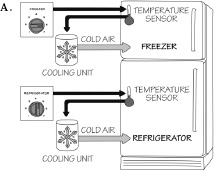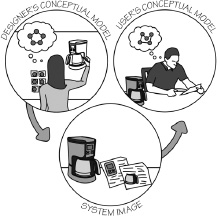Read The Design of Everyday Things Online
Authors: Don Norman
The Design of Everyday Things (8 page)
FIGURE 1.8.
  Â
Junghans Mega 1000 Digital Radio Controlled Watch.
There is no good conceptual model for understanding the operation of my watch. It has five buttons with no hints as to what each one does. And yes, the buttons do different things in their different modes. But it is a very nice-looking watch, and always has the exact time because it checks official radio time stations. (The top row of the display is the date: Wednesday, February 20, the eighth week of the year.) (Photograph by the author.)
What happens when the device does not suggest a good conceptual model? Consider my digital watch with five buttons: two along the top, two along the bottom, and one on the left side (
Figure 1.8
). What is each button for? How would you set the time? There is no way to tellâno evident relationship between the operating controls and the functions, no constraints, no apparent mappings. Moreover, the buttons have multiple ways of being used. Two of the buttons do different things when pushed quickly or when kept depressed for several seconds. Some operations require simultaneous depression of several of the buttons. The only way to tell how to work the watch is to read the manual, over and over again. With the scissors, moving the handle makes the blades move. The watch provides no
visible relationship between the buttons and the possible actions, no discernible relationship between the actions and the end results. I really like the watch: too bad I can't remember all the functions.
Conceptual models are valuable in providing understanding, in predicting how things will behave, and in figuring out what to do when things do not go as planned. A good conceptual model allows us to predict the effects of our actions. Without a good model, we operate by rote, blindly; we do operations as we were told to do them; we can't fully appreciate why, what effects to expect, or what to do if things go wrong. As long as things work properly, we can manage. When things go wrong, however, or when we come upon a novel situation, then we need a deeper understanding, a good model.
For everyday things, conceptual models need not be very complex. After all, scissors, pens, and light switches are pretty simple devices. There is no need to understand the underlying physics or chemistry of each device we own, just the relationship between the controls and the outcomes. When the model presented to us is inadequate or wrong (or, worse, nonexistent), we can have difficulties. Let me tell you about my refrigerator.

FIGURE 1.9.
  Â
Refrigerator Controls.
Two compartmentsâ fresh food and freezerâand two controls (in the fresh food unit). Your task: Suppose the freezer is too cold, the fresh food section just right. How would you adjust the controls so as to make the freezer warmer and keep the fresh food the same? (Photograph by the author.)
I used to own an ordinary, two-compartment refrigeratorânothing very fancy about it. The problem was that I couldn't set the temperature properly. There were only two things to do: adjust the temperature of the freezer compartment and adjust the temperature
of the fresh food compartment. And there were two controls, one labeled “freezer,” the other “refrigerator.” What's the problem?
Oh, perhaps I'd better warn you. The two controls are not independent. The freezer control also affects the fresh food temperature, and the fresh food control also affects the freezer. Moreover, the manual warns that one should “always allow twenty-four (24) hours for the temperature to stabilize whether setting the controls for the first time or making an adjustment.”


FIGURE 1.10.
  Â
Two Conceptual Models for a Refrigerator.
The conceptual model A is provided by the system image of the refrigerator as gleaned from the controls. Each control determines the temperature of the named part of the refrigerator. This means that each compartment has its own temperature sensor and cooling unit. This is wrong. The correct conceptual model is shown in B. There is no way of knowing where the temperature sensor is located so it is shown outside the refrigerator. The freezer control determines the freezer temperature (so is this where the sensor is located?). The refrigerator control determines how much of the cold air goes to the freezer and how much to the refrigerator.
It was extremely difficult to regulate the temperature of my old refrigerator. Why? Because the controls suggest a false conceptual model. Two compartments, two controls, which implies that each control is responsible for the temperature of the compartment that carries its name: this conceptual model is shown in
Figure 1.10A.
It is wrong. In fact, there is only one thermostat and only one cooling mechanism. One control adjusts the thermostat setting, the other the relative proportion of cold air sent to each of the two compartments of the refrigerator. This is why the two controls interact: this conceptual model is shown in
Figure 1.10B.
In addition, there must be a temperature sensor, but there is no way of knowing where it is located. With the conceptual model suggested by the controls,
adjusting the temperatures is almost impossible and always frustrating. Given the correct model, life would be much easier.
Why did the manufacturer suggest the wrong conceptual model? We will never know. In the twenty-five years since the publication of the first edition of this book, I have had many letters from people thanking me for explaining their confusing refrigerator, but never any communication from the manufacturer (General Electric). Perhaps the designers thought the correct model was too complex, that the model they were giving was easier to understand. But with the wrong conceptual model, it was impossible to set the controls. And even though I am convinced I knew the correct model, I still couldn't accurately adjust the temperatures because the refrigerator design made it impossible to discover which control was for the temperature sensor, which for the relative proportion of cold air, and in which compartment the sensor was located. The lack of immediate feedback for the actions did not help: it took twenty-four hours to see whether the new setting was appropriate. I shouldn't have to keep a laboratory notebook and do controlled experiments just to set the temperature of my refrigerator.
I am happy to say that I no longer own that refrigerator. Instead I have one that has two separate controls, one in the fresh food compartment, one in the freezer compartment. Each control is nicely calibrated in degrees and labeled with the name of the compartment it controls. The two compartments are independent: setting the temperature in one has no effect on the temperature in the other. This solution, although ideal, does cost more. But far less expensive solutions are possible. With today's inexpensive sensors and motors, it should be possible to have a single cooling unit with a motor-controlled valve controlling the relative proportion of cold air diverted to each compartment. A simple, inexpensive computer chip could regulate the cooling unit and valve position so that the temperatures in the two compartments match their targets. A bit more work for the engineering design team? Yes, but the results would be worth it. Alas, General Electric is still selling refrigerators with the very same controls and mechanisms that cause so much
confusion. The photograph in
Figure 1.9
is from a contemporary refrigerator, photographed in a store while preparing this book.
People create mental models of themselves, others, the environment, and the things with which they interact. These are conceptual models formed through experience, training, and instruction. These models serve as guides to help achieve our goals and in understanding the world.
How do we form an appropriate conceptual model for the devices we interact with? We cannot talk to the designer, so we rely upon whatever information is available to us: what the device looks like, what we know from using similar things in the past, what was told to us in the sales literature, by salespeople and advertisements, by articles we may have read, by the product website and instruction manuals. I call the combined information available to us the
system image
. When the system image is incoherent or inappropriate, as in the case of the refrigerator, then the user cannot easily use the device. If it is incomplete or contradictory, there will be trouble.
As illustrated in
Figure 1.11
, the designer of the product and the person using the product form somewhat disconnected vertices of a triangle. The designer's conceptual model is the designer's conception of the product, occupying one vertex of the triangle. The product itself is no longer with the designer, so it is isolated as a second vertex, perhaps sitting on the user's kitchen counter. The system image is what can be perceived from the physical structure that has been built (including documentation, instructions, signifiers, and any information available from websites and help lines). The user's conceptual model comes from the system image, through interaction with the product, reading, searching for online information, and from whatever manuals are provided. The designer expects the user's model to be identical to the design model, but because designers cannot communicate directly with users, the entire burden of communication is on the system image.

FIGURE 1.11.
  Â
The Designer's Model, the User's Model, and the System Image.
The designer's conceptual model is the designer's conception of the look, feel, and operation of a product. The system image is what can be derived from the physical structure that has been built (including documentation). The user's mental model is developed through interaction with the product and the system image. Designers expect the user's model to be identical to their own, but because they cannot communicate directly with the user, the burden of communication is with the system image.
Figure 1.11
indicates why communication is such an important aspect of good design. No matter how brilliant the product, if people cannot use it, it will receive poor reviews. It is up to the designer to provide the appropriate information to make the product understandable and usable. Most important is the provision of a good conceptual model that guides the user when thing go wrong. With a good conceptual model, people can figure out what has happened and correct the things that went wrong. Without a good model, they struggle, often making matters worse.
